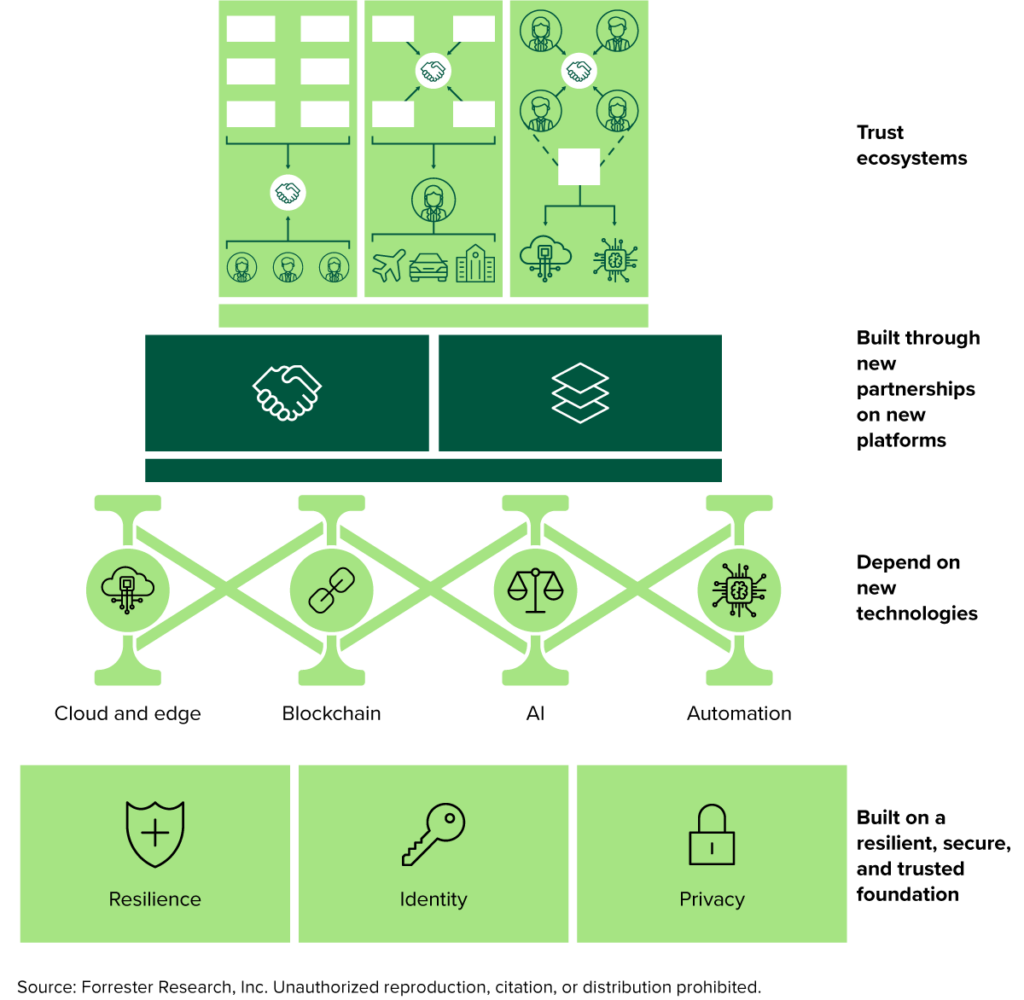Forrester’s 2021 Top Trends And Technologies Point Toward Trust Ecosystems
Trust Ecosystems Are Emerging As A Powerful Disruptor Of Big Tech
In The Top Trends and Technologies To Watch, Q3 2021, my coauthors Ted Schadler, Christian Austin, and I summarize many of our 2021 trends. The report weaves together a narrative that points toward “trust ecosystems,” which we define this way:
Trust ecosystems are an affinity between customers and brands that work together because the economics, value exchange, and regulations of a market reinforce the parameters of trust.
I really like the definition, which came from Ted. Nice job, partner!
By 2030, trust ecosystems — not “big tech” — will rule markets. You can already see an example of an emerging trust ecosystem in Instacart. Instacart started as a two-sided platform business connecting consumers and a variety of local grocery stores. But it has gone much further. We’ve found that:
- The twist is the human in the loop. At Instacart, consumers communicate directly with contract shoppers to make decisions based on real store inventory. This is more than just ordering a taxi or booking a hotel room and hoping it meets your needs. Instacart must constantly work to earn the trust of its customers, its contract shoppers, and its grocer partners.
- Trust between firms and humans begets growth opportunities. Instacart just announced an expanded partnership with national giant Walmart in three California markets and Tulsa, OK. We see a huge set of additional partnership opportunities growing out of this food delivery ecosystem. The result is a major challenge to Amazon’s tentative grip on the fresh-food-to-your-door demand.
- Instacart is threatening Amazon, but not due to technology. Instacart differentiates because of the measures it takes to keep consumers believing that they can get what they want delivered quickly. With Instacart, you can provide instructions to your shopper on what to do if an item is out of stock. Your shopper can message you if your instructions are not clear. And your fresh food is delivered on the same day via a flexible delivery schedule.
Mastering Trust And Ecosystem Business Models Creates Growth
Firms that master trust and ecosystem-based business models will dominate the decade, and our 2021 technology trends point this out. Here are some highlights:
- New platforms create new partnership opportunities that evolve toward ecosystems. No firm can go it alone anymore. Instead, we see industry cloud platforms evolving into a firmament for ecosystem growth. AI collaboration networks are one element supporting this shift. This new way of building AI unleashes the power of machine learning with less data sharing and risk. Furthermore, API-first commerce solutions help firms avoid re-platforming. Instead, they offer business functions as swappable technology components delivered as a service. Low code, API management, software-as-a-service digital business, and marketplaces are examples of new platforms. These are also creating new partnership opportunities.
- Trends in emerging technology scaffolding support new business models based on trust. Large categories of emerging technology have become scaffolding for new platforms. Cloud native and edge are animating new platform solutions. Or, consider how blockchain is becoming a critical trust infrastructure. Also, ethical AI is rescuing trust amid an explosion in automation. Further, we identify how “specialized compute infrastructure” (SCI) points toward new insights and business opportunities.
- Advancements in trust infrastructure will help firms build a resilient foundation. Technology scaffolding needs a solid foundation that helps firms manage risk and delivery on security. In our report, we identify how systemic risk is elevating the importance of business resilience, while product security is becoming a defining characteristic of customer trust. The rise of nonhuman identities will drive the evolution of identity and access management technologies to handle robots and smart devices. Privacy-preserving technologies, sustainability technologies such as climate risk analytics, and decentralized digital identity management are all important foundational technologies.
This figure from the report organizes the trend into a four-layer wedding cake:

This Year’s Research Is Bigger, Better, And Bolder
We did quite a bit of work behind the scenes that allowed us to build on our previous work in this area. Specifically:
- We published more trends and improved our trends report format. Not only did we update the 15 trends we wrote last year, we also created 11 more — for a total of 26. This year’s top trends and technologies report highlights many of these trends, but you can read a summary of them all in our companion report Forrester’s 2021 Technology Trends. We also improved the report format by adding recommendations and providing links to our technology research hub.
- We identified more technologies in our research. This year, our report identifies over 75 technologies across a spectrum of very new to more mature. You can see these technologies in the tables in the final section of the report, The Top Trends And Technologies To Watch, Q3 2021.
- We created a unified technology research hub. Clients subscribing to Forrester Decisions now have access to a single digital hub, Tech Landscapes & Waves, that aggregates our research on all 370-plus technologies we cover. Each page in the hub includes the definition, bullets on why the technology is useful, and links to related research, such as market landscapes, Forrester Wave™ reports, and more.
